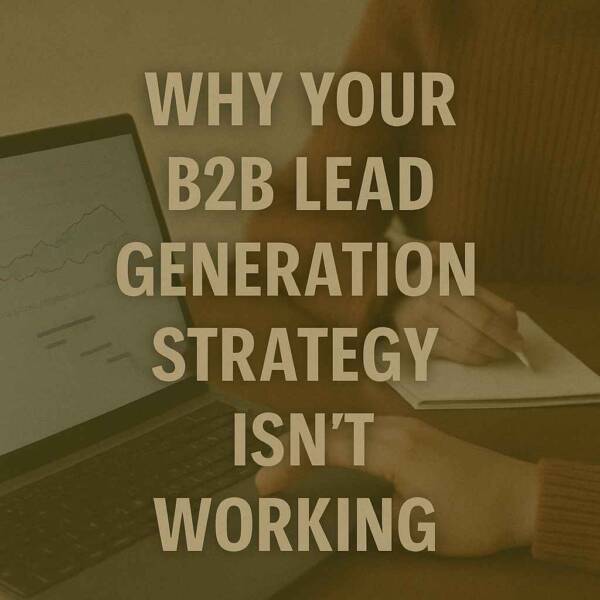The Biggest Lead Generation Mistakes That Are Costing You Money
Lead generation is important for businesses. It helps them find new customers. However, many companies make mistakes. These mistakes can cost money. Understanding these errors can help businesses improve. This article will discuss the biggest lead generation mistakes. We will look at how to avoid them and save money.
Not Defining Your Target Audience Clearly
![]()
One major mistake is not knowing who your audience is. A target audience is a specific group of people. They are the ones most likely to buy your product or service. If you don’t know them, you might waste time and money.
Defining your target audience involves several steps:
- Research demographics like age, gender, and location.
- Understand their interests and needs.
- Find out where they spend time online.
- Look at competitors to see who they target.
- Create customer personas based on your findings.
For example, a company selling video games should target gamers. They should focus on young adults aged 18-34 who enjoy action games. If they target everyone, they may attract the wrong people.
Statistics show that businesses with a clear target audience have better results. They generate more leads and convert them into sales. Knowing your audience saves resources and increases effectiveness.
In contrast, companies that do not define their audience often struggle. They may run ads that do not connect with anyone. This leads to wasted ad spend and poor engagement rates.
To avoid this mistake, take time to research and define your audience. Use surveys, social media insights, and market research to gather information. The more you know, the better your lead generation efforts will be.
Ignoring the Importance of Quality Content
![]()
Content is king in lead generation. Many businesses think any content will do. This is a big mistake. Quality content attracts the right leads. It keeps them engaged and interested.
Quality content has several characteristics:
- It provides valuable information to the reader.
- It is well-researched and fact-checked.
- It is easy to read and understand.
- It includes visuals like images and videos.
- It encourages interaction through comments or shares.
For instance, a health food brand could create recipes using their products. These recipes can be shared on their website and social media. This type of content draws in health-conscious customers.
Studies show that businesses that produce high-quality content see better engagement. They get more website visits and higher conversion rates. Good content builds trust. It makes potential customers feel confident in buying from you.
On the other hand, low-quality content can harm your brand. It can make you seem unprofessional or unreliable. People may leave your site quickly if they do not find what they need.
To succeed, focus on creating quality content. Take time to plan and produce useful articles, videos, and infographics. Invest in good writing and design. This will pay off in the long run.
Failing to Track and Analyze Performance Metrics
![]()
Tracking performance metrics is essential. Many businesses overlook this step. They fail to analyze how their lead generation efforts are doing. This can lead to missed opportunities and wasted budget.
Key performance metrics include:
- Conversion rate: the percentage of visitors who become leads.
- Cost per lead: how much you spend to generate a single lead.
- Traffic sources: where your leads are coming from.
- Engagement rate: how actively users interact with your content.
- Return on investment (ROI): how much revenue you earn from your leads.
For example, if a business notices a low conversion rate, it may need to adjust its strategy. Perhaps the landing page is confusing or the offer is not attractive enough. By analyzing data, they can make necessary changes.
Research shows that businesses that track their metrics perform better. They can identify what works and what doesn’t. This allows them to optimize their lead generation strategies.
Conversely, failing to track metrics can result in poor decisions. You may continue spending money on ineffective campaigns. This leads to lost leads and revenue.
To avoid this mistake, set up analytics tools. Regularly review your performance data. Make adjustments based on what you learn. This will help you become more effective in generating leads.
Neglecting Follow-Up Strategies for Leads
![]()
Following up with leads is crucial. Many businesses forget to do this. They assume that one interaction is enough. This is a costly mistake. Without follow-ups, leads can go cold.
Effective follow-up strategies include:
- Sending personalized emails after initial contact.
- Making phone calls to answer any questions.
- Offering additional resources or discounts.
- Setting reminders for future check-ins.
- Using marketing automation tools for timely follow-ups.
For instance, a real estate agent can send a thank-you email after a showing. They can also provide helpful information about the area. This keeps the conversation going and shows care.
Studies indicate that timely follow-ups increase conversion rates. Businesses that follow up within 24 hours have a higher chance of closing deals. Quick responses demonstrate eagerness and professionalism.
On the flip side, neglecting follow-ups can lead to lost opportunities. Potential customers may forget about you or choose competitors. This results in decreased sales and revenue.
To avoid this pitfall, develop a follow-up plan. Decide how and when to contact leads after their initial interest. Stay organized and consistent in your approach.
Relying Solely on One Lead Generation Channel
![]()
Diverse lead generation channels are important. Relying on just one channel can be risky. If that channel fails, your leads will dry up. This can hurt your business significantly.
Common lead generation channels include:
- Social media platforms like Facebook and Instagram.
- Email marketing campaigns.
- Search engine optimization (SEO) for organic traffic.
- Paid advertising like Google Ads.
- Networking and events.
For example, a clothing brand might rely only on Instagram for leads. If their account gets banned or engagement drops, they lose potential customers. Diversifying channels helps mitigate this risk.
Research shows that businesses using multiple channels see better results. They reach different audiences and increase their chances of converting leads. More channels mean more opportunities to engage with potential customers.
On the other hand, focusing solely on one channel can limit growth. You may miss out on leads from other platforms. This can lead to stagnation and reduced revenue.
To prevent this issue, explore various lead generation methods. Test and measure their effectiveness. Create a balanced strategy to maximize your reach.
Overlooking Mobile Optimization in Lead Generation
![]()
Mobile optimization is often ignored. Many people use smartphones to browse the internet. If your website isn’t mobile-friendly, you may lose leads.
Key aspects of mobile optimization include:
- Responsive design that adjusts to different screen sizes.
- Fast loading times for pages and images.
- Easy navigation with clear menus and buttons.
- Readable text without zooming in.
- Accessible forms that are simple to fill out on mobile devices.
For instance, an e-commerce site should ensure its checkout process is smooth on mobile. Complicated steps can frustrate users and lead to cart abandonment.
Statistics reveal that over half of web traffic comes from mobile devices. Businesses that optimize for mobile see higher conversion rates. Users are more likely to complete actions on user-friendly sites.
Conversely, neglecting mobile optimization can harm your lead generation. Visitors may leave your site quickly if they can’t navigate easily. This translates into lost leads and revenue.
To avoid this mistake, test your website on various devices. Make improvements based on user experience. Prioritize mobile optimization to capture more leads.
Conclusion: The Biggest Lead Generation Mistakes
![]()
Lead generation is vital for business success. Avoiding common mistakes can save money and improve results. Here are the key takeaways:
- Define your target audience clearly.
- Create high-quality, engaging content.
- Track and analyze your performance metrics.
- Implement effective follow-up strategies.
- Diversify your lead generation channels.
- Optimize your website for mobile users.
By focusing on these areas, businesses can enhance their lead generation efforts. This leads to more customers and increased sales. Remember, small changes can make a big difference!




